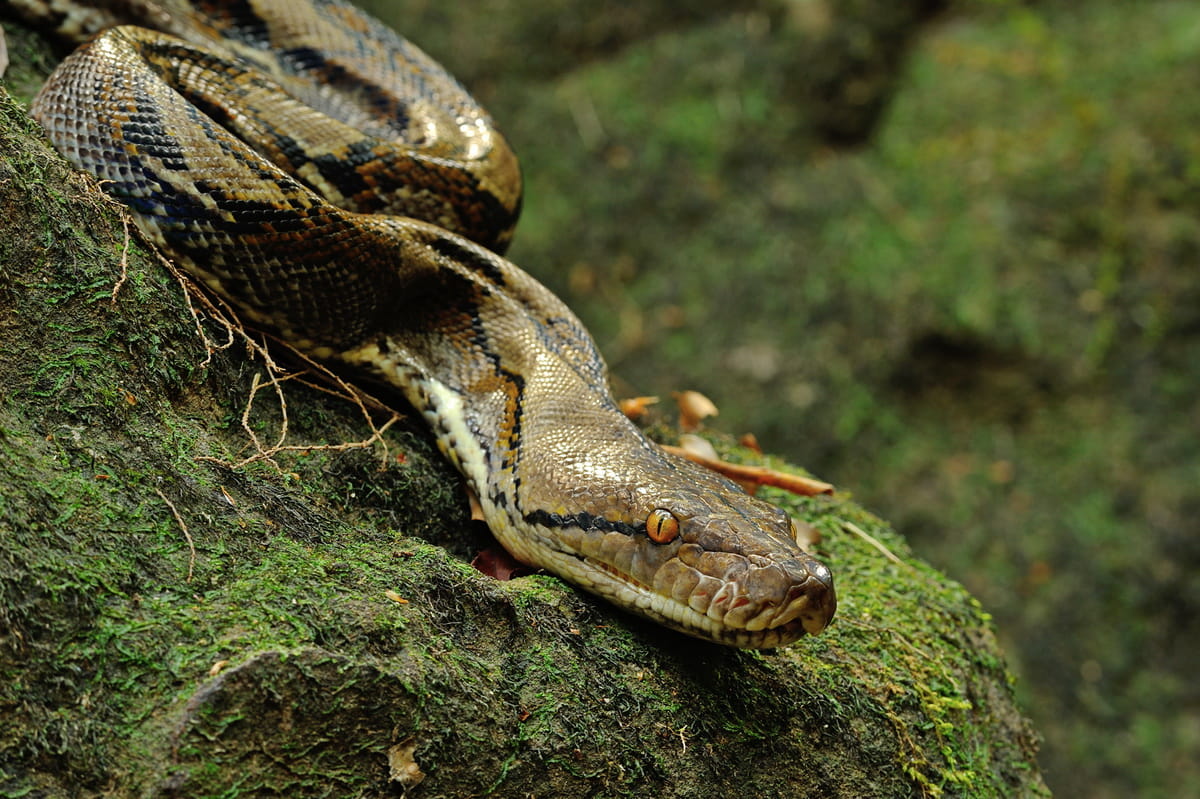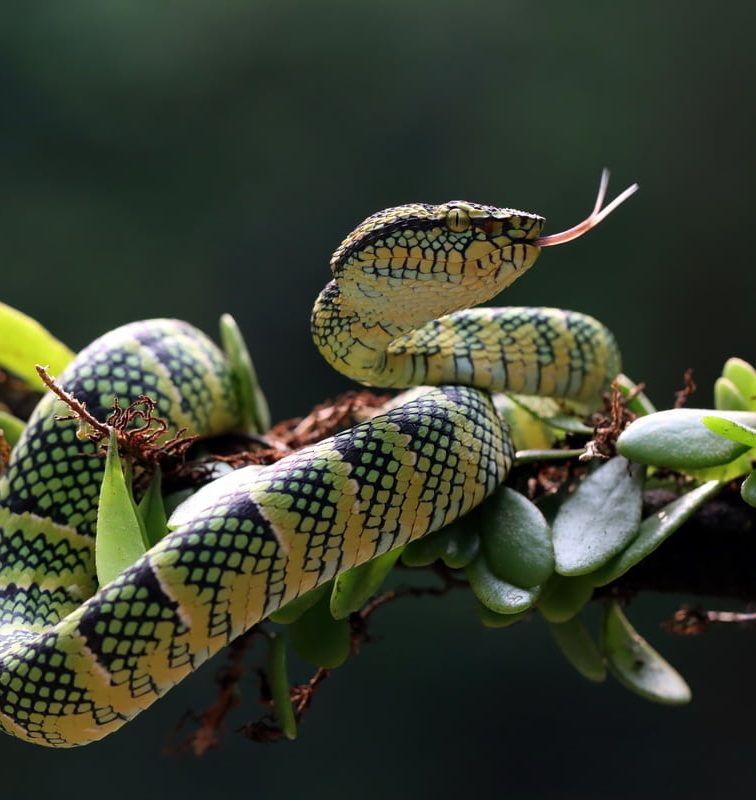Reticulated pythons (Malayopython reticulatus), the world’s longest snakes, are not only record-holders in size but also marvels of nature. Measuring up to an astonishing 32 feet, they are found predominantly in Southeast Asia.
Known for their striking scale patterns, these pythons have adapted to various environments, from dense rainforests to human-inhabited areas. Their ability to consume prey much larger than themselves, including deer and pigs, demonstrates their significant role in their ecosystems.
Let’s delve deeper into these magnificent creatures, exploring their unique characteristics and behaviors, and uncover some fun facts about reticulated pythons.
1. World’s Longest Snake: Record-Breaking Reticulated Pythons
Reticulated pythons are officially the world’s longest snakes. A python caught in Sulawesi, Indonesia, in 1912 was measured at an unprecedented 32 feet (9.75 meters), earning them this title. These giants are not just long but also incredibly heavy, with some weighing over 350 pounds. Despite their size, they are excellent swimmers and can travel significant distances across water bodies.
Their large size is crucial for their survival, enabling them to capture and consume large prey. This ability is a key factor in maintaining the balance in their ecosystems, controlling populations of smaller animals.

Image: readablecard.com
2. Unique Scale Patterns: The Art of Camouflage
Reticulated pythons are named for their unique scale patterns, resembling a complex net. This pattern is an evolutionary adaptation for camouflage, blending seamlessly with the forest floor and foliage. Each scale is a work of art, with intricate designs that vary from one individual to another.
These scales are not just for hiding; they also play a vital role in thermoregulation. The python can adjust its body temperature by exposing different parts of its body, covered in these scales, to the sun or shade. This adaptation is crucial for their survival in the varying climates of Southeast Asia.

Natasha de Vere / Flickr
3. Diet of Giants: What Reticulated Pythons Eat
Reticulated pythons have a diverse diet, consuming anything from small rodents to large mammals like pigs and deer. This opportunistic feeding behavior is essential for their survival in varied environments. They are ambush predators, lying in wait for hours or even days to catch unsuspecting prey.
Their method of killing is constriction, where they coil around their prey, exerting enough pressure to cause suffocation. Studies have shown that they can exert pressure of over 90 psi, making their constriction method highly efficient. This ability to consume large prey is a testament to their adaptability and strength in the wild.
4. Reticulated Python Habitat: From Rainforests to Human Areas
Reticulated pythons thrive in a variety of habitats, ranging from dense rainforests to wetlands, and even extending to human-dominated areas. Their adaptability is key to their survival, with an ability to thrive in environments ranging from sea level to highland areas. This adaptability is a remarkable trait, allowing them to occupy a range of ecological niches.
Despite their versatility, habitat loss and fragmentation pose significant threats to their populations. These pythons often venture into human settlements in search of food, leading to conflicts. Conservation efforts focus on preserving their natural habitats and mitigating human-wildlife conflict.
5. Reproduction: The Fascinating Birth Process
The reproduction process of reticulated pythons is as fascinating as their size. Females lay a large clutch of eggs, sometimes up to 100, which they incubate for around 90 days. During this period, the female python exhibits an extraordinary behavior called ‘shivering thermogenesis’ to maintain the eggs’ temperature.
This maternal investment ensures a high survival rate for the hatchlings. Once hatched, the young pythons are independent and receive no further care from their mother. Their early independence is crucial for survival, as it allows them to quickly adapt and fend for themselves in their complex environments.
6. Lifespan and Growth: Surviving Decades
Reticulated pythons have a surprisingly long lifespan, especially in captivity, where they can live up to 20-30 years. In the wild, their lifespan is slightly shorter due to predation and environmental challenges. Growth is rapid in the first few years, with pythons reaching substantial lengths in a relatively short period.
Their growth rate is influenced by various factors, including diet, habitat, and health. As they grow, they shed their skin multiple times a year, a process essential for their growth and health. This shedding not only signifies growth but also helps to remove parasites and maintain skin health.
7. Python vs Anaconda: Debunking Common Myths
There’s often confusion between reticulated pythons and anacondas, two of the world’s largest snakes. While reticulated pythons hold the record for length, anacondas, specifically the green anaconda, are the heaviest. Anacondas are predominantly found in South America, while reticulated pythons are native to Southeast Asia.
Another distinction lies in their habitats and swimming abilities. Anacondas spend a lot of their time in water, while reticulated pythons, though good swimmers, are more often found on land. Debunking these common myths helps in understanding the distinct ecological roles and behaviors of these impressive serpents.
8. Human-Python Interactions: Coexistence and Conflict
Interactions between humans and reticulated pythons are complex, ranging from reverence in some cultures to fear and conflict in others. In certain areas, they are considered sacred, while in others, they pose a threat to livestock and occasionally humans, leading to conflicts.
Efforts to promote coexistence include educating communities about python behavior and habitat conservation. Understanding these magnificent creatures reduces fear and fosters a more harmonious relationship. However, as human settlements expand into their habitats, conflicts are likely to increase, emphasizing the need for sustainable solutions.
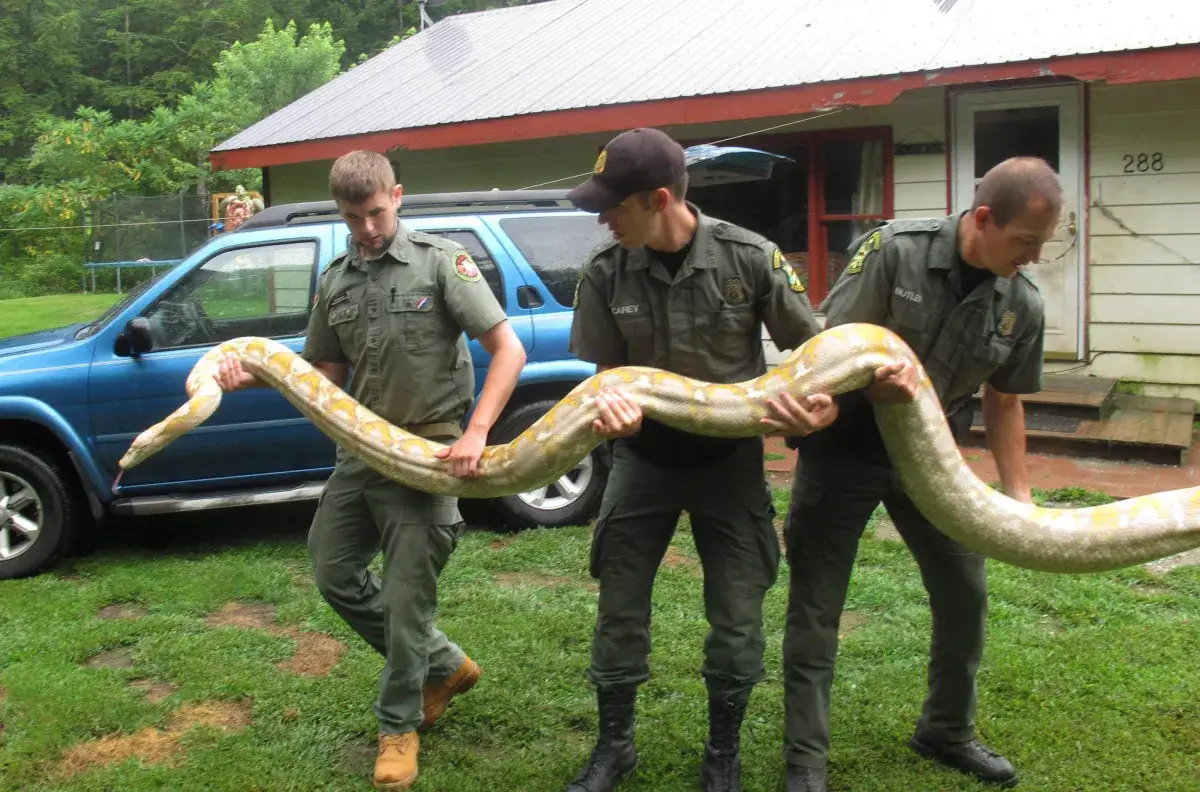
Image: globalnews.ca
9. Conservation Status: Threats and Protections
Reticulated pythons are currently listed as “Least Concern” by the IUCN Red List, but they face various threats that could jeopardize their future. Habitat loss due to deforestation and human encroachment is a significant challenge. Additionally, they are hunted for their skin, used in the fashion industry, and for the pet trade, often leading to overexploitation.
Conservation efforts include habitat protection, sustainable trade regulations, and breeding programs in zoos. These efforts aim to maintain healthy wild populations and prevent the species from sliding into a vulnerable status. Education and awareness campaigns also play a crucial role in their conservation.
10. Incredible Strength: Hunting and Constriction Techniques
Reticulated pythons are renowned for their incredible strength, particularly in their hunting and constriction techniques. They are ambush predators, striking swiftly at unsuspecting prey and then coiling around it with immense power. Their muscular bodies enable them to exert significant pressure, suffocating the prey quickly and efficiently.
This method of hunting showcases not just physical strength but also strategic intelligence. The python’s ability to judge the required force and its precise application reflects a high level of predatory skill. This method is highly effective, allowing them to take down animals much larger than themselves.
11. Sensory Abilities: Seeing the World Differently
Reticulated pythons have unique sensory abilities that set them apart from many other species. They possess heat-sensing pits along their jaws, allowing them to detect the body heat of their prey, even in complete darkness. This adaptation is crucial for hunting in their native dense forest environments.
Their eyesight, while not their primary sense for hunting, is adapted to detect movement, aiding them in locating prey and navigating their surroundings. These sensory adaptations highlight the python’s evolutionary success and their specialized role as nocturnal hunters in their ecosystems.
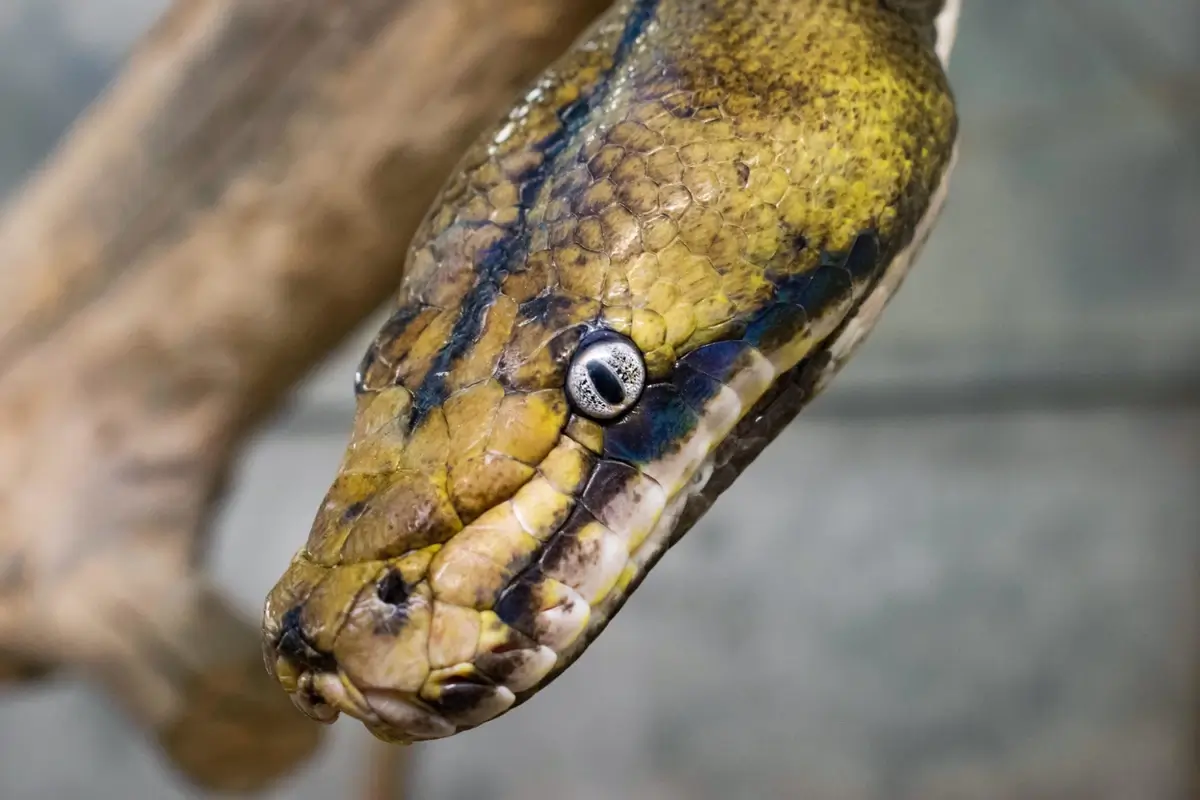
Image: awsfzoo.com
12. Cultural Significance: Mythology and Symbolism
In Southeast Asia, reticulated pythons are deeply woven into mythology and culture, symbolizing strength, wisdom, and spiritual connection. They feature in Indonesian folklore as guardians of sacred sites, embodying both physical and spiritual realms. Their skin-shedding is linked to rebirth, influencing religious rituals and art. Python motifs are prominent in batik fabrics, representing power and protection, and in temple sculptures symbolizing royal and religious iconography.
These cultural portrayals underscore the reticulated python’s profound impact on human beliefs and artistic expression.
13. Role in Ecosystem: Apex Predator Dynamics
Reticulated pythons, as apex predators, are vital for ecosystem balance, controlling prey populations from rodents to ungulates. Their hunting efficiency prevents prey overpopulation and ecosystem strain. A healthy python population often indicates a thriving ecosystem.
Conservation of these pythons aids broader ecological network preservation, highlighting their critical ecological role.
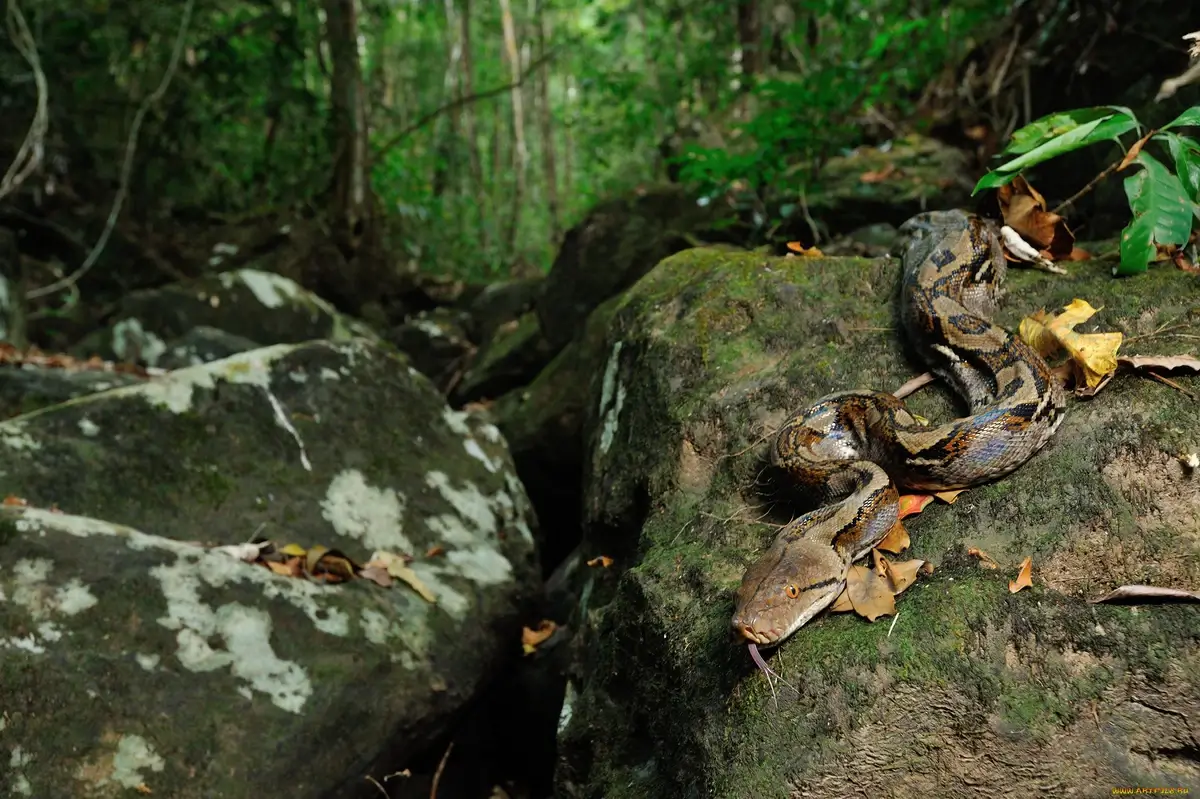
Image: flickriver.com
14. Reticulated Python in Captivity: Pets and Zoos
Reticulated pythons are a common sight in zoos and, increasingly, in the pet trade. In captivity, they require large enclosures and specialized care due to their size and dietary needs. Zoos play a vital role in educating the public about these pythons, often contributing to conservation efforts through breeding programs. The longest recorded captive python was over 25 feet long, living in a zoo setting.
However, their popularity as pets raises concerns. They are not suitable for novice reptile owners due to their size and strength. Inadequate care or handling can lead to stress for the animal and potential danger for the owner.

shankar s. / Flickr
15. Temperature Regulation: Surviving in Diverse Climates
Reticulated pythons exhibit remarkable ability to regulate their body temperature, a vital skill for survival in diverse climates. They are ectothermic, relying on external heat sources to regulate their body temperature. In cooler weather, they bask in the sun to warm up, while in hot conditions, they seek shade or water to cool down.
This ability to thermoregulate allows them to thrive in a range of environments, from humid rainforests to drier woodland areas. Research has shown that their preferred body temperature is around 86-88 degrees Fahrenheit, a key factor in their hunting efficiency and digestive processes.
16. Swimming Skills: Aquatic Adaptations
Reticulated pythons are excellent swimmers, an adaptation that sets them apart from many other python species. They can move swiftly in water, using their muscular bodies to propel themselves. This skill not only aids in hunting but also in migration across islands in their native range.
Their swimming ability has been observed in natural settings, where they can cross rivers and even travel in the open sea. This aquatic proficiency enables them to colonize new areas, increasing their range and access to different prey. It also serves as an escape mechanism from predators or human threats.
17. Territorial Behavior and Social Structure
Reticulated pythons are generally solitary creatures, exhibiting territorial behavior, especially during the breeding season. They have a defined home range, which they patrol and defend against other pythons. This territoriality is more pronounced in males, who may engage in combat for mating rights.
While not social in the conventional sense, reticulated pythons do interact during mating. Outside of the breeding season, they prefer to remain isolated, avoiding encounters with other pythons. This solitary nature is a key aspect of their survival strategy, reducing competition for resources and potential conflicts.
18. Unique Color Variations and Morphs
Reticulated pythons are known for their diverse color variations and morphs, especially in captivity. These morphs are the result of selective breeding, showcasing a range of colors and patterns that differ significantly from their wild counterparts. Common morphs include albino, tiger, and golden, each with distinct patterns and hues.
These color variations do not just appeal to reptile enthusiasts; they also offer insights into genetics and hereditary traits. Studies on these morphs contribute to understanding genetic diversity and mutation processes in reptiles. However, it’s important to note that in the wild, their natural pattern provides crucial camouflage, essential for their survival.
FAQ
What are the unique characteristics of the reticulated python?
Reticulated pythons are known for being the longest snakes in the world, with some reaching over 30 feet. Their scale patterns are distinctive, featuring a complex, net-like design that provides excellent camouflage. These pythons are adept swimmers, capable of crossing large bodies of water. They have heat-sensing pits near their mouths for detecting warm-blooded prey and are excellent constrictors, using their powerful bodies to subdue prey.
How smart are reticulated pythons?
While measuring intelligence in snakes is challenging, reticulated pythons exhibit behaviors indicative of problem-solving abilities and learning. They can navigate complex environments, remember locations with abundant prey, and adjust hunting strategies based on the situation. However, their intelligence is primarily instinctual, geared towards survival rather than the cognitive processes typically associated with mammalian intelligence.
Do reticulated pythons sleep?
Yes, reticulated pythons do sleep, although their sleep patterns differ from those of mammals. They enter a restful state where they are less responsive to their environment but can quickly awaken if disturbed. This state of rest is crucial for their health and well-being, allowing them to conserve energy for hunting and other activities.
How fast can a reticulated python run?
Reticulated pythons are not built for speed on land and do not “run.” They can move quickly in a straight line, especially when striking prey, but generally, they are slow-moving creatures. Their strength lies in their stealth and ability to ambush prey, rather than in chasing it down.
Can reticulated python bite?
Yes, reticulated pythons can bite, and their bites can be severe due to their size and the number of sharp teeth they possess. They typically bite either in self-defense or when they mistake something for food. A bite from a reticulated python should be treated promptly due to the risk of infection.
Why are reticulated pythons so popular?
Reticulated pythons are popular due to their impressive size, unique beauty, and the fascination they evoke. They are often featured in documentaries and wildlife shows, increasing public interest. In the pet trade, their various color morphs and patterns make them appealing to reptile enthusiasts. However, their care requirements and size make them suitable only for experienced keepers.
Are reticulated pythons safe pets?
Reticulated pythons can be kept as pets but are not considered safe for inexperienced handlers. Due to their size and strength, they require specialized care, large enclosures, and should be handled with caution. Potential owners should be well-versed in their care and understand the commitment required to keep such a large and potentially dangerous animal.
How often do reticulated pythons poop?
The frequency of bowel movements in reticulated pythons varies based on their diet and metabolism. Typically, they defecate once every few weeks to once a month. This low frequency is due to their slow metabolism and the nature of their diet, consisting mostly of meat, which leaves less waste material.
What eats reticulated pythons?
In the wild, young reticulated pythons are vulnerable to predators like birds of prey, large mammals, and even other large snakes. However, adult reticulated pythons have few natural predators due to their size and strength. Human beings are the primary threat to adult pythons, either through hunting or habitat destruction.


